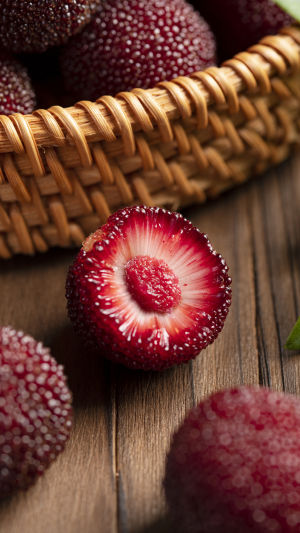Chinese bayberry, a beloved fruit in southern China, has captured the hearts of many with its delectable taste and unique aroma.
However, beneath its unassuming appearance lies a treasure trove of trivia and wonders. This article aims to delve into the depths of Chinese bayberry, unraveling its mysteries for all to appreciate.
<h3>1. Partnered Growth:</h3>
Chinese bayberry trees stand out from ordinary fruit trees due to their dioecious nature. This means that male and female flowers grow on separate trees, requiring cross-pollination for fruit production.
Unlike the more common monoecious plants, such as corn or peaches, where both male and female flowers grow on the same plant, Chinese bayberry trees necessitate the presence of both genders for fruit-bearing.
<h3>2. Nutritional Value:</h3>
Chinese bayberry isn't just a treat for the taste buds; it's also a nutritional powerhouse. Bursting with vitamin C, vitamin E, various amino acids, and minerals, it offers antioxidant properties, boosts the immune system, and promotes skin health.
Its rich anthocyanin content is particularly noteworthy for its antioxidant effects and cardiovascular health benefits.
<h3>3. Regional Suitability:</h3>
While Chinese bayberry thrives in the warm, humid climates of southern China, its cultivation in northern regions poses challenges. These trees prefer acidic soil conditions, which are prevalent south of the Yangtze River.
Attempts to cultivate them in neutral or alkaline soils of northern areas require soil pH adjustments and controlled environments like greenhouses, though large-scale endeavors await further scientific exploration.
<h3>4. Edible Parts and Precautions:</h3>
Apart from the fleshy mesocarp, Chinese bayberries consist mainly of columnar protrusions called flesh columns, derived from the exocarp. While these provide a juicy delight, they may harbor harmless fruit fly larvae.
Soaking the berries in saltwater before consumption helps expel larvae, ensuring a safer eating experience. The corrosive gastric acid in humans effectively digests any ingested larvae, rendering them harmless.
<h3>5. Harvesting Season:</h3>
The peak season for harvesting Chinese bayberries spans from June to August, aligning with the summer months. Different varieties may ripen at slightly varied times, but a general indicator is the transition from green to red fruit coloration.
Once ripe, the berries offer a delightful blend of sweetness and tartness, ready for picking and indulging.
<h3>6. Culinary Applications:</h3>
Chinese bayberries, with their sweet, tangy flavor and juicy texture, are best enjoyed fresh but can also be processed into various products for extended shelf life and diverse culinary experiences.
From sauces to preserves, these creations capture the essence of Chinese bayberry while offering new taste sensations.
<h3>7. Medicinal Significance:</h3>
Beyond its culinary allure, Chinese bayberry holds medicinal value, as documented in the "Compendium of Materia Medica."
With its acidic and cooling properties, it aids in heat-clearing, detoxification, fluid production, thirst-quenching, lung moistening, and cough relief. These attributes render it a valuable adjunct in treating certain heat-related ailments.
By exploring these intriguing facets, we gain a deeper appreciation for the Chinese bayberry fruit and its multifaceted nature. As we anticipate its continued presence and prominence, Chinese bayberry promises to captivate palates and enrich culinary experiences for generations to come.
Chinese Bayberry: an Exquisite and Delicious Fruit
Viedo by Glopen





